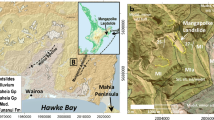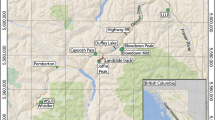Abstract
The summit crater of Mt Ruapehu volcano normally hosts a 15.4-ha warm lake, whose water has been repeatedly wholly or partly ejected by explosive and extrusive eruptions. Some of the larger eruptions have modified the lake outlet by burying it under unconsolidated tephra (volcanic ash and blocks), creating a dam-break flood hazard independently of the occurrence of an eruption. Eruptions in 1995 and 1996 followed this sequence; a break-out flood was anticipated and a warning system was installed to mitigate the risk from this event and subsequent lahars in the same catchment. The 11-year filling time allowed much planning and rehearsal. The warning system involved manual inspections of dam integrity, and seepage and lake-level monitoring to constrain the likely failure window, and telemetered instruments including a tripwire and geophones to detect breaching of the dam and propagation of the outbreak flood. The dam-collapse sequence, captured by a time-lapse camera, involved a series of retrogressing landslides initiated and accelerated by seepage forces and toe scour when the lake was 1.1 m below overtopping. The barrier failed in two phases on 18th March, 2007, beginning at 09:55 (NZST), with rapid retreat of one of the erosion scarps on the downstream slope of the eastern barrier, initiated by internal erosion. Headward retrogression of the scarp into the barrier formed an initial breach in the dam, after which increasing outflow led to erosion and undercutting of the wider downstream toe of the western barrier. A final, larger dam breach occurred between 11:21 and 11:22 as slope instability caused retrogressive failure of the remaining barrier. Five-hundred meters downstream of the dam, a large landslide was reactivated by toe scour during the flood, contributing about a million cubic meters of solid material to the volumetric bulking of the outflow, which reached the coast, 215 km away, 17 h later. The success of the planning and warning system allowed the whole event to occur with little damage to infrastructure and without causing injury.











Similar content being viewed by others
Notes
All heights are given in metres above mean sea level datum
References
Bornas MA, Team QR (2002) The 2001 Mount Pinatubo Crater Lake breakout crisis, 23rd Annual PNOC-EDC Geothermal Conference, Hotel Inter-Continental. Makati City, Philippines, pp 7–16
Bornas MA, Tungol N, Maximo RPR, Paladio-Melosantos ML, Mirabueno HT, Javier DV, Corpuz EG, Dela Cruz EG, Ramos AF, Marilla JD, Villacorte EU (2003) Caldera-rim breach and lahar from Mt. Pinatubo, Philippines: Natural breaching and resulting lahar. Proceedings, IUGG 2003 Congress, Sapporo, Japan, p A558
Carrivick JL, Manville V, Cronin SJ (2009) A fluid dynamics approach to modelling the 18th March 2007 lahar at Mt. Ruapehu, New Zealand. Bull Volcanol 71:153–169
Christenson BW, Wood CP (1993) Evolution of a vent-hosted hydrothermal system beneath Ruapehu Crater Lake, New Zealand. Bull Volcanol 55:547–565
Cronin SJ, Hodgson KA, Neall VE, Palmer AS, Lecointre JA (1997a) 1995 Ruapehu lahars in relation to the late Holocene lahars of Whangaehu River, New Zealand. N Z J Geol Geophys 40(4):507–520
Cronin SJ, Neall VE, Lecointre JA, Palmer AS (1997b) Changes in Whangaehu River lahar characteristics during the 1995 eruption sequence, Ruapehu volcano, New Zealand. J Volcanol Geotherm Res 76:47–61
Gillon M, Fell R, Keys HJR, Foster M (2006) A contribution to public safety studies—failure modes and likelihood analysis for a tephra dam on an active volcano. Bulletin of ANCOLD (Australian National Committee on Large Dams), 134. pp. 11–22
Hancox G, Nairn I, Otway P, Webby M, Perrin N, Keys H (1997) Stability assessment of Mt Ruapehu crater rim following the 1995–1996 eruptions. GNS client report 43605B
Hancox G, Keys H, Webby M (2001) Assessment and mitigation of dam-break lahar hazards from Mt Ruapehu Crater Lake following the 1995–96 eruptions. In: Geotechnical Society 2001 symposium, Engineering & Development in Hazardous Terrain. Christchurch, 24–25 August 2001
Hodgson KA, Manville V (1999) Sedimentology and flow behaviour of a rain-triggered lahar, Mangatoetoenui Stream, Ruapehu volcano, New Zealand. Geol Soc Amer Bull 111:743–754
Hodgson KA, Lecointre J, Neall VE (2007) Onetapu formation: the last 2000 yr of laharic activity at Ruapehu volcano, New Zealand. N Z J Geol Geophys 50(2):81–99
Johnston DM, Houghton BF, Neall VE, Ronan KR, Paton D (2000) Impacts of the 1945 and 1995–1996 Ruapehu eruptions, New Zealand: an example of increasing societal vulnerability. Geol Soc Amer bull 112:720–726
Keys H (2003) Minor change confirmed in the elevation of the lava surface controlling the overflow of Crater Lake, Mount Ruapehu. Department of Conservation internal report for the Crater Lake Scientific and Technical Advisory Panel
Keys HJR, Green PM (2008) Ruapehu lahar New Zealand 18 March 2007: Lessons for hazard assessment and risk mitigation 1995–2007. Journal of Disaster Research 3(4):284–296
Kilgour GN, Manville V, Della Pasqua F, Graettinger A, Hodgson KA, Jolly G (2009) The 25 September 2007 eruption of Mount Ruapehu, New Zealand: directed ballistics, surtseyan jets, and ice-slurry lahars. J Volcanol Geotherm Res in press
Lecointre J, Hodgson KA, Neall VE, Cronin SJ (2004) Lahar-triggering mechanisms and hazard at Ruapehu volcano, New Zealand. Nat Hazards 31:85–109
Lube G, Cronin SJ, Procter JN (2009) Explaining the extreme mobility of volcanic ice-slurry flows, Ruapehu volcano, New Zealand. Geology 37:15–18
Manville V (2004) Palaeohydraulic analysis of the 1953 Tangiwai lahar: New Zealand's worst volcanic disaster. Acta Vulcanologica XVI(1/2):137–152
Manville V, Cronin SJ (2007) Break-out lahar from New Zealand's Crater Lake. EOS Trans AGU 88:441–442
Manville V, Hodgson KA, Houghton BF, Keys HJR, White JDL (2000) Tephra, snow and water: complex sedimentary responses at an active, snow-capped stratovolcano, Ruapehu, New Zealand. Bull Volcanol 62:278–293
Manville V, Hodgson KA, Nairn IA (2007a) A review of break-out floods from volcanogenic lakes in New Zealand. N Z J Geol Geophys 52:131–150
Manville V, Massey C, Hancox G, Keys H (2007b) Characterising the initiation of the 18th March 2007 Ruapehu Crater Lake Lahar. IUGG Special session of the IAVCEI Commission of volcanogenic sediments VS022. Perugia, Italy
Massey CI, Nelis S, Keys HJR (2007) Whangaehu Landslide—Preliminary findings from the inspection carried out on 25April 2007. GeoNet landslide response report
Nairn IA, Wood CP, Hewson CAY (1979) Phreatic eruptions of Ruapehu: April 1975. N Z J Geol Geophys 22:155–173
New Zealand Geotechnical Society (2005) Description of soil and rock. Guidelines for the field classification and description of soil and rock for engineering purposes
O'Shea BE (1954) Ruapehu and the Tangiwai disaster. N Z J Sci Technol B36:174–189
Pierson TC (2005) Hyperconcentrated flow—transitional process between water flow and debris flow. In: Jakob M, Hungr O (eds) Debris-flow hazards and related phenomena. Praxis. Springer, Berlin, pp 159–202
STAP (2003) Second report to Minister on possible hazard created by filling of Crater Lake, Ruapehu and potential lahar. Crater Lake Scientific and Technical Advisory Panel, 14 May 2002
Turner G, Ingham M, Bibby H (2007) Electrical resistivity monitoring of seepage and stability of the tephra barrier at Crater Lake, Mt Ruapehu, New Zealand. Geophys Res Abstr 9:11630
Acknowledgements
This work was funded by a variety of agencies of the New Zealand Government. The authors acknowledge the following people for their input to this investigation: Robin Fell (Unisearch Ltd), Murray Gillon (DamWatch), Neville Palmer (GNS Science), Stuart Read (GNS Science) and Reece Gardener (Astrolabe). The paper benefited from helpful comments by Professor Chia-Nan Liu and an anonymous reviewer.
Author information
Authors and Affiliations
Corresponding author
Additional information
Vernon Manville is formerly from GNS Science.
Rights and permissions
About this article
Cite this article
Massey, C.I., Manville, V., Hancox, G.H. et al. Out-burst flood (lahar) triggered by retrogressive landsliding, 18 March 2007 at Mt Ruapehu, New Zealand—a successful early warning. Landslides 7, 303–315 (2010). https://doi.org/10.1007/s10346-009-0180-5
Received:
Accepted:
Published:
Issue Date:
DOI: https://doi.org/10.1007/s10346-009-0180-5




